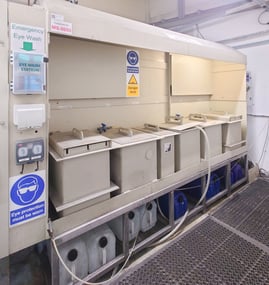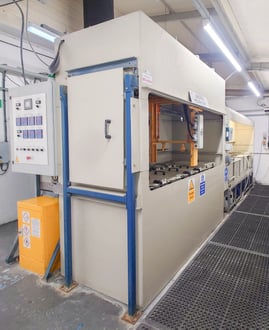Metals Used for Metal Plating

A versatile surface finishing process capable of expanding the potential uses of any component/object the range of materials and components than can be plated by modern plating methods is very wide. New treatments, alloys and preparation techniques are constantly being developed and refined.
At the core of plating is the choice final properties required and therefore the metal(s) required to achieve those properties. Keep reading to find out about the main uses of metals and their alloys.
Metals Used for Metal Plating
Nickel
One of the metals used most frequently is an undercoat layer to prepare a component for further plating, Nickel is the most used metal in electroless plating to add conductive properties to non-conductive substrates. Along with its strong adhesive properties, automobile companies use it for pre-coating components ready for chrome plating.
It's not just preparation work it's useful for, with its good corrosion and wear resistance, plus a bright lustre appeal, nickel is a very practical plating material all around for plating and making alloys with too.
Copper
The other go-to for applying conductivity to a component, copper is one of the most used metals used in metal plating. An effective material to physically plate with, for a friendly cost, copper can be seen a lot in the electrical industry for connecting the circuitry and the components themselves.
Zinc
A metal that has good resistance to oxidation and humid conditions, zinc is the metal used for galvanising steel and iron components. As steel and iron are vulnerable to oxidation, zinc protects the metal from rusting while maintaining the strength and durability of the components themselves. Used in any industry that can be exposed to the elements, zinc finished components can be seen in architectural structures, railway tracks and screws/nails.
Chrome
Most known for its decorative qualities, especially in the automotive industry, there is more to chrome than just a pretty finish. Its resistance to corrosion, water, and abrasive wear makes chrome an effective protective layer that also has a highly desired decorative finish; great for external applications.
Aluminium
A plating metal with no shortage of alloy variations to provide a great range of properties. The properties aluminium and its alloys can apply include improved conductivity that could rival the conductivity of copper. While others alloys could have high heat resistance and durability, making them perfect for heavy duty mechanical applications.
Tin
A ductile, silvery metal that is conductive, corrosion resistant & non-toxic, tin is most notably used for tinned/canned goods such as food, drink beverages and paint. It is also used to enhance the solderability of solder and provide the conductive coating for battery connectors.
What Properties Do Noble Metals Bring to Metal Plating?
Noble metals are a range of metals known for their premium plating properties. Made up of 8 metals, all with some of the best & highest resistance properties on the elemental table, these highly desirable metals are frequently used for plating methods like immersion plating.
Gold
Featuring a highly desired and recognisable finish that implies an increased value, the functional properties of gold that make it highly resistant to oxidation and a great electrical conductor, contributing to what makes gold plating highly desirable. Platers who can afford the price tag of plating in gold will be aware of gold's tendency to tarnish, a quality that can be resolved by adding nickel to the plating process.
Silver
Another great conductor but for a reduced cost, silver has the lowest surface resistance of all metals for excellent lubricity & high thermal resistance. Great for mechanical uses such as nuts, fasteners, slip rings and washers. Silver reduces abrasive wear with sliding parts, galling, making it perfect for those small connecting components. However, it must be cautioned that it is vulnerable to tarnishing as it is susceptible to flaking and cracking in humid environments.
Rhodium
A type of metal similar to its fellow noble metal, platinum, rhodium is a metal used a lot in the jewellery industry. Although unlike silver and gold (both frequently used in jewellery too) you may not realise it. Resistant to tarnishing and scratches, the white lustrous appearance of rhodium makes it popular for white gold finishes.
The other noble metals & their properties include:
- Ruthenium – A lesser known metal, ruthenium still has the same high corrosion resistance and conductivity as all the other noble metals with an increased hardness. Added to platinum and palladium for stronger components, its silvery white finish can be used for jewellery while its strength can be utilised in the aircraft industry.
- Palladium – With a very high resistance to corrosion, palladium is considered a highly valuable metal just like gold & platinum. Used frequently in the jewellery and dentistry industries.
- Osmium – One of the highest density elements, osmium is used for its hardness and very high heat resistance. Typically used for electrical contacts & fountain-pen nibs.
- Iridium – Its corrosion resistance quality impervious to high temperature applications makes iridium an invaluable metal when it comes to high electrical components such as spark plugs, electrical contacts and precious-metal crucibles.
- Platinum – One of the highest valued for its rarity, aesthetics, and durability, platinum is a very versatile metal with great catalytic, corrosion resistant and tarnishing resistance properties. Its highly appealing finish makes it desirable and functional for high valued jewellery, electrical applications and medical implants.
What Materials Can Be Metal Plated?
It is often assumed that metal plating can only be achieved on metal components but plastic, glass, fabric and organics materials can be plated with the right process. Electroplating needs a conductive component so non-conductive materials need a preparation layer applying using electroless or immersion plating. Read more about plating methods.
Challenges of Metal Plating Specific Materials
With no shortage of substrate options to metal plate, a plater must always consider the individual characteristics of the materials as they can feature traits that require additional processes to manage.
For example, not all plastics can withstand the preparation and plating process needed for plating on plastic. One of the most popular plastics to plate is ABS thermoplastic (acrylonitrile butadiene styrene). Its resistance to chemicals along with its durability makes it desirable for manufacturing components but as it is also not too physically strong, that’s where metal plating comes in to resolve the issue. The additional step that is required the make this reality is chemical etching to prepare and improve the surface adhesion for plating.
Another substrate material with a characteristic to cater to is aluminium’s vulnerability to oxidization. As metal plating typically takes place in an aqueous solution, the exposure to the liquid element can cause the surface layer of the aluminium to oxidise and obstruct the adhesion of the metal application. However, this reaction can be controlled and prevented by coating the substrate in a zinc immersion film. The layer acts as an unofficial galvanising layer so the aluminium can be metal plated without the risk of oxidising.
Metal Plating Lines We Can Offer You
With so many materials to plate and to plate with, the properties that can be gained by the components in this process have been expanding since early silver plating 200 years ago.
Most frequently applied today in the form of plating lines, these treatment lines have been a specialty of Riley Surface World for over 55 years. Recognising the value of these lines both used & new, we have provided individuals within the industry with quality plating equipment at a more competitive cost for years. All while saving the machinery for a new lease of life rather than going to scrap.
If you’re in the market to sell your plating line or looking to buy, contact us at 01922 45 8000 with your opportunity/requirements.
Furthermore, check out our Electroplating & Treatment Lines range to see what we have available for you.
For more insight on metal plating, why not check out our article on Leading Methods of Metal Plating.
Jacquet Weston Engineering Packaged Demineralisation Water Treatment Plant
Manually operated, the de-mineralisation unit produces up to 200 l/h when connected to a 1,000 litre holding tank. At the estimated hourly production of 45 l/h demineralised water the unit will need regenerating every 75-80 hours.
- Stock No
- MA748
- Category
- Electroplating & treatment lines
- Model
- Jacquet Weston Engineering Ion Exchange Plant
- Work Envelope (WxDxH mm) [?]
- Brake / Storage Tank Ø900 x 1500
- Process Stages
- Single Stage
- Other Info
- Producing up to 200 litres/hour
- Condition
- From a working environment, Good Condition
- Sold As Seen Price [?]
- £ 1,250 (+ VAT)
- Special Price (sold as seen) [?]
- Login or Register for price.
- Special offer ends
- 05 November 2025 15:00 GMT while stocks last
Eagle Engineering and Pioneer Prototype Unused, 14 Stage, Semi-Auto, Rack & Barrel Plating Plant
An Unused, 14 Stage, Polypropylene Barrel Plating Plant with Transporter. Includes two barrels and can be commissioned and adapted by the OEM.
- Stock No
- PIO5701
- Category
- Electroplating & treatment lines
- Model
- Eagle Engineering and Pioneer Prototype Manual
- Year of Manufacture
- 2023
- Work Envelope (WxDxH mm) [?]
- 830 x 580/1235/1480 x 645
- Process Stages
- 14
- Other Info
- Barrels 2 off 385mm wide 300mm Ø
- Condition
- Brand New, Excellent Condition, Unused, Current Model
- Location
- Hereford, UK
- Direct Site Clearance Price [?]
- £ Login or Register for price.
- Part of a Direct Site Clearance
- Unused Rack & Barrel Semi-Automatic Plating Plant
Balco Engineering Ltd Manual Electropolish Line
An ideal opportunity to acquire a manual Electropolishing Line installed by Balco Engineering Limited in 2013 and subject to an upgrade by them in 2016.The line is utilised in the production of medical implants. The plant is fully operational and can currently be viewed working by prospective buyers.
- Stock No
- TEC300
- Category
- Electroplating & treatment lines
- Model
- Balco Engineering Ltd Manual Electropolish
- Year of Manufacture
- 2013
- Work Envelope (WxDxH mm) [?]
- 200/320/360/390 x 500 x 500
- Process Stages
- 6
- Other Info
- Wall mounted control cabinet containing
- Condition
- From a working environment, Seen working by RSW, Good Condition
- Location
- Sheffield, UK
- Direct Site Clearance Price [?]
- £ Login or Register for price.
- Part of a Direct Site Clearance
- Tecomet Medical Industry Vibratory & Electropolishing Finishing Lines
Balco Engineering Ltd Automatic Electropolish Line
An ideal opportunity to acquire an automatic electropolishing line, installed by Balco Engineering Limited in 2016 utilised in the production of medical implants. The plant is fully operational and can currently be viewed working by prospective buyers.
- Stock No
- TEC400
- Category
- Electroplating & treatment lines
- Model
- Balco Engineering Ltd Automatic Electropolish
- Year of Manufacture
- 2016
- Work Envelope (WxDxH mm) [?]
- 260/360 x 500 x 650
- Process Stages
- 6
- Other Info
- Fume Exhaust System (4,386 CFM)
- Condition
- From a working environment, Seen working by RSW, Good Condition
- Location
- Sheffield, UK
- Direct Site Clearance Price [?]
- £ Login or Register for price.
- Part of a Direct Site Clearance
- Tecomet Medical Industry Vibratory & Electropolishing Finishing Lines
Machines & equipment for sale
- Surface Treatment
- Cleaning & Degreasing
- Polishing & Belt Linishing
- Mass Finishing
- Ovens & Furnaces
- Process Cooling
- Shot Blasting
- Dust & Fume Extraction
- Air Compressors
- Rectifiers & Transformers
- Miscellaneous
- Latest Stock
- Special Offers
- Direct From Site Clearances
- Auctions
- Brand New Machines
- Available Immediately
- Sell Your Machine
Machine Alert
Get the latest machines emailed directly to you as they become available to buy online. Sign Up Now







